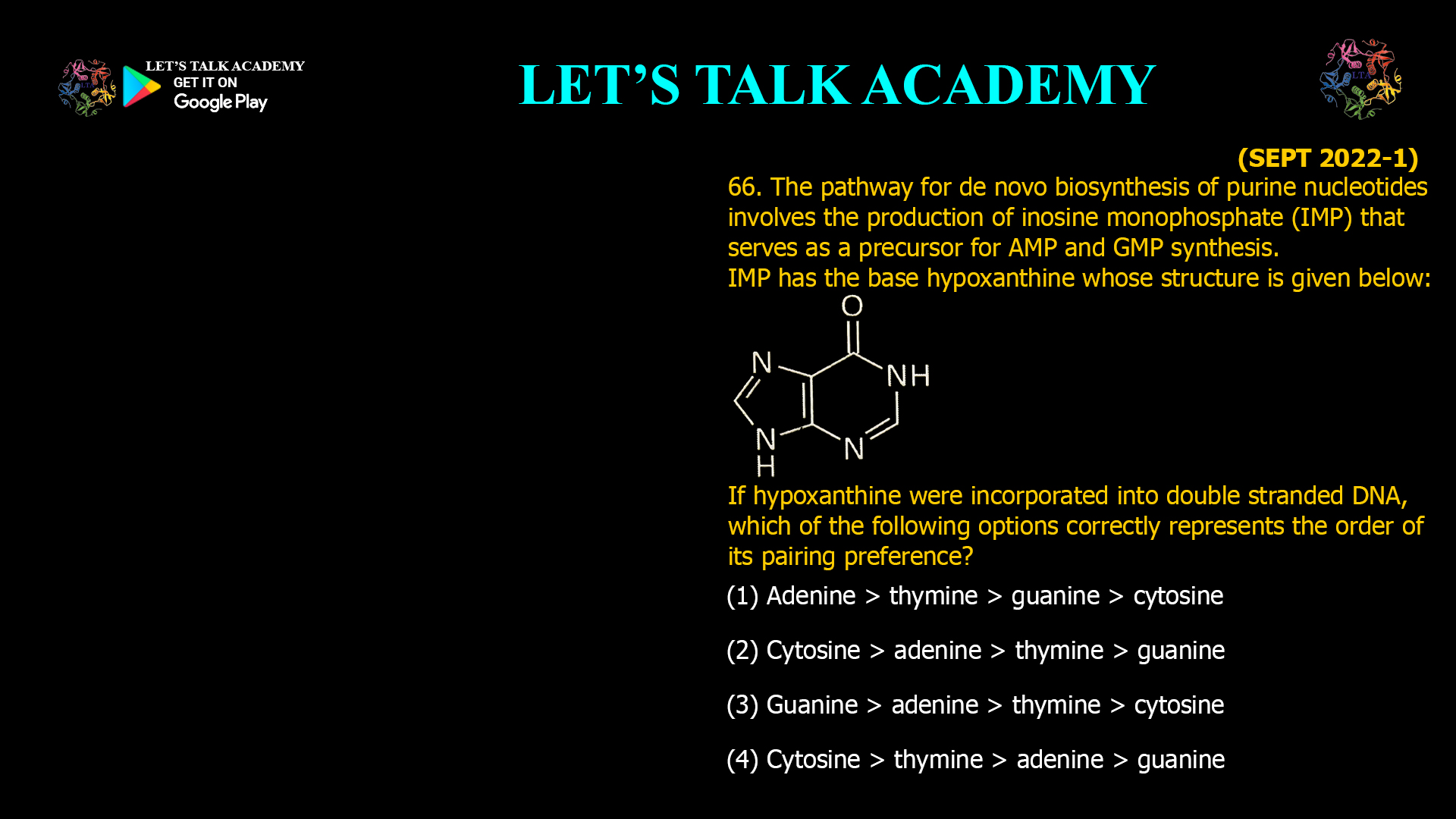- The pathway for de novo biosynthesis of purine nucleotides involves the production of inosine monophosphate (IMP) that serves as a precursor for AMP and GMP synthesis. IMP has the base hypoxanthine whose structure is given below:
If hypoxanthine were incorporated into double stranded DNA, which of the following options correctly represents the order of its pairing preference?
(1) Adenine > thymine > guanine > cytosine
(2) Cytosine > adenine > thymine > guanine
(3) Guanine > adenine > thymine > cytosine
(4) Cytosine > thymine > adenine > guanine
Hypoxanthine is a purine derivative found in inosine monophosphate (IMP), a key intermediate in purine nucleotide biosynthesis. When incorporated into DNA, hypoxanthine can pair with natural DNA bases, influencing DNA stability and mutation rates. Understanding its base pairing preferences is essential for insights into mutagenesis, DNA repair, and nucleic acid chemistry.
This article explains the order of base pairing preference of hypoxanthine in double-stranded DNA.
Background: Hypoxanthine in DNA
-
Hypoxanthine arises naturally as the deamination product of adenine.
-
It is present in nucleotides like inosine and can be incorporated into nucleic acids.
-
Hypoxanthine’s ability to pair with multiple bases can lead to mutations if not repaired.
Base Pairing Preferences of Hypoxanthine
-
Experimental and computational studies show that hypoxanthine pairs most stably with cytosine (C).
-
This pairing mimics the guanine-cytosine (G-C) base pair due to similar hydrogen bonding patterns.
-
Hypoxanthine can also pair, though less stably, with adenine (A), thymine (T), and guanine (G).
-
The relative order of pairing stability in DNA is:
Cytosine > Adenine > Thymine > Guanine
-
This order is supported by thermodynamic data, molecular dynamics simulations, and biochemical assays.
Implications of Hypoxanthine-Cytosine Pairing
-
Hypoxanthine pairing with cytosine can cause A→G transition mutations during DNA replication.
-
DNA repair enzymes recognize and remove hypoxanthine to maintain genomic integrity.
-
The preferential pairing with cytosine explains the mutagenic potential of adenine deamination.
Summary Table: Hypoxanthine Pairing Preference Order
Rank Base Pairing Stability with Hypoxanthine 1 Cytosine (C) Highest 2 Adenine (A) Moderate 3 Thymine (T) Lower 4 Guanine (G) Lowest Conclusion
The correct order of base pairing preference of hypoxanthine incorporated into double-stranded DNA is:
(2) Cytosine > adenine > thymine > guanine
This order reflects the strongest and most biologically relevant base pairing interactions of hypoxanthine, with cytosine being the preferred partner.
-




16 Comments
Aakansha sharma Sharma
September 19, 2025The correct order of base pairing preference of hypoxanthine incorporated into double-stranded DNA is:
(2) Cytosine > adenine > thymine > guanine
Muskan singodiya
September 19, 2025Cytosine > adenine > thymine > guanine
Khushi Vaishnav
September 23, 2025Cytosine > Adenine > Thymine > Guanine
Priya khandal
September 24, 2025Cytosine>adenine>thymine >Guanine
Rishita
September 24, 2025The correct order of base pairing preference of hypoxanthine incorporated into double-stranded DNA is…..
Option 2
Cytosine > adenine > thymine > guanine
Rishita
September 24, 2025The correct order of base pairing preference of hypoxanthine incorporated into double-stranded DNA is…..
Option 2
Cytosine > adenine > thymine > guanine
Kirti Agarwal
September 24, 2025Opt 2
Aakansha sharma Sharma
September 24, 2025Cytosine > adenine > thymine > guanine
Manisha choudhary
September 25, 2025Hypoxanthin cytosine s paring krta h to A-G transition mutation krta h DNA m
Oder of pairing=C>A>T>G
Arushi Saini
September 26, 20252) Cytosine > adenine > thymine > guanine
Varsha Tatla
September 27, 2025CATG
Mahima Sharma
September 27, 2025hypoxanthine pairs most stably with cytosine
Then A>T>G
Kavita Choudhary
September 28, 2025cytosine < adenine < thymine < guanine
Kajal
September 30, 2025Option 2or CATG…
Santosh Saini
October 4, 2025Hypoxanthine pairing preference order is – cytosine > adenine >thymine > guanine
Komal Sharma
November 7, 2025The correct order of base pairing preference of hypoxanthine incorporated into double-stranded DNA is:
(2) Cytosine > adenine > thymine > guanine
This order reflects the strongest and most biologically relevant base pairing interactions of hypoxanthine, with cytosine being the preferred partner.